

By
Don and Linda Freedman
Search
TheTravelzine
TheTravelzine Group
Access Your Mail
Don's
Gallery
Packing
Hints
Planning
Tips
Cities
Links
Links
LINKS TO OUR TRAVELOGUES
Argentina, Buenos Aires - Jan-Mar 2010
Argentina, Buenos Aires - Jan-Mar 2009
Argentina, Buenos Aires - Jan-Mar 2008
Austria - Fall 2005
Belgium, Brussels - Fall 2000
Canada - Summer 2002
Canada - Summer 2001
Canada - Summer 2000
Czech Republic - Spring 2000
France - Fall 2002
France, Paris - Fall 2000
France, Paris - Spring 1999
France, Lyon - Spring 1999
Germany, Berlin - Fall 2009
Germany - Fall 2002
Germany - Spring 2000
Germany - Fall 1999
Greece - Fall 2012
Greece - Fall 1999
Greece - Fall 1997
Hungary - Spring 2000
Israel - Fall 1999
Italy - Winter 2007
Italy - Winter 2006
Italy - Winter 2005
Italy - Winter 2004
Italy - Winter 2003
Italy - Winter 2001
Italy - Fall 1998
Italy - Fall 1996
Netherlands - Spring 2000
Portugal, Azores - 2019
Portugal, Azores - 2018
Portugal, Sao Miguel & Lisbon - 2017
Portugal, Azores - 2017
Portugal, Azores - 2016
Portugal, Azores - 2015
Portugal, Azores - 2014
Portugal, Azores - 2013
Portugal, Azores - 2012
Portugal, Azores - 2011
Portugal, Lisbon - 2011
Portugal - Fall 2006
Portugal - Fall 2004
Portugal - Fall 2003
Portugal - Fall 2001
Portugal - Spring 1999
Portugal - Spring 1997
Slovakia - Spring 2000
Slovenia - Spring 1999
Slovenia - Fall 1996
Spain, Barcelona - Winter 2006
Switzerland - Fall 2002
Switzerland - Spring 2000
Switzerland - Spring 1999
Switzerland - Fall 1998
Switzerland - Fall 1997
Switzerland - Spring 1996
U.S. Florida, Key West - Fall 2006
U.S. Florida - Spring 2001
U.S. Maine - Summer 2002
U.S. Massachusetts - Summer 2003
U.S. Massachusetts - Summer 2002
U.S. Massachusetts - Summer 2001
U.S. New York State - Fall 2005
U.S. New York State - Summer 2004
U.S. New York State - Summer 2003
U.S. New York State - Summer 2001
U.S. Washington,DC - Spring 2000
AUSTRIA
FALL 2005
Wachau_Krems_Melk_Durnstein
Salzburg | Kufstein_Kitzbuehel
Rattenberg_Hall | Innsbruck
Zell Am See_Kaprun | Spittal
Klagenfurt | Graz | Vienna
Wachau, Krems, Melk and Durnstein
Faced with the dilemma of picking our fall destination, inspiration came from my food cravings. My longing for the seasonal specialties of deer, venison, chestnuts, mushrooms, and cranberries complemented by good wine and beer won the day. With senses now aroused and thoughts of forests bursting with color tumbling down mountainsides to green valleys of smooth rolling pastures and crystal lakes, rivers rushing through precious villages and sweet smelling vineyards, it was time to return to Austria.
Were I not so eager for stewed deer, we'd have waited until 2006, the 250th birthday of the brilliant composer Wolfgang Amadeus Mozart. A year of celebration starts on his birthday, January 27, in his two home towns Salzburg, where he was born and studied composition, and Vienna, where he had his greatest triumphs.
Our three-week itinerary would start in the east in Lower Austria, we'd travel west to Salzburger Land and Tirol, return east to Carinthia and Styria, and finish the trip in Vienna.
We prefer to travel by train between major destinations and Austrian Railways has an extensive network that made it very easy and efficient. The cars were clean and comfortable and we always arrived pretty much on time. The conductors were cheerful, polite and helpful which was an added plus.
Austrian Airlines has direct flights from Toronto to Vienna
which was very convenient. The onboard service was
excellent, the staff pleasant and caring, and arrivals
were on schedule. The meals were quite good and beverage
service was maintained throughout the flights. 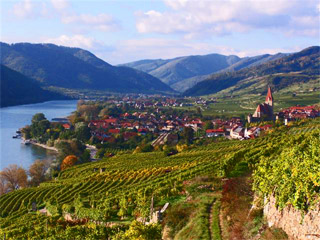
The Wachau region of Lower Austria was our first stop. Due to
its mild climate people began settling here thousands of
years ago. It was awarded a European Diploma by the
Council of Europe and is on the UNESCO World Heritage
List as a protected cultural landscape. It is easy to see
why it has been so recognized. Terraced vineyards climb
up the hillsides above the Danube, small towns and
villages grace the shoreline and beyond, boasting a
mosaic of colorful architecture from Baroque, to Gothic
and Renaissance blending into the landscape creating a
symphony of visual delight.
[Back
to Top]
We settled into the Steigenberger Avance Hotel, in Krems. Located slightly above the town center it affords lovely views of the town and surrounding tiered vineyards. This sprawling, still- expanding, property with obliging, smiling staff has a bright cheerful atrium lobby with a multi-level bar/lounge and library.
Our twin-bedded room was nicely furnished with the basic comforts. There were bathrobes and slippers for pool and spa use. CNN was available to keep us up to date. We were all set!
We were to find the buffet breakfasts to be exceptional throughout our trip. Great coffee is offered immediately. The breads and rolls in this country are a dream – crusty and dense with grains, nuts and seeds through and through. There’s always a great selection of meats, eggs and cheese and for the health conscious, muesli, cereals, fruits, vegetables, yogurt and juices. The dining room is bright and cheerful with views of the sun-drenched, nearby vineyards. If it was just a bit warmer we could have enjoyed the inviting terrace.
Krems is a well preserved medieval
town, which has existed for 1000 years. With 26,000
inhabitants it's the largest town of the Wachau. The
pretty park in the center is surrounded by eye-catching
pastel-colored buildings. The Gasthof Alte Post, dating
to 1584, with a lovely arcaded courtyard was once the
seat of the postmaster. There are shops at street level
and apartments above. A palace-like structure is the
Danube University of Krems, Austria's only post graduate
university. It was built in 1922 as a tobacco factory and
converted to a university in 1995. With the university
and other private schools in town, there were many
students around enjoying the cafes, shops and restaurants.
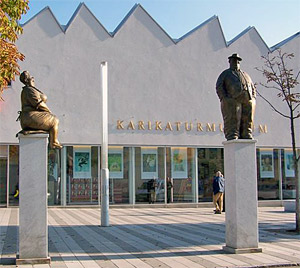
Krems boasts the first and only cartoon museum in Austria (Karikaturmuseum). We found it quite amusing. Of particular note were the works of "Sokol" featuring national and international politics and "Manfred Deix" expressing the Austrian mentality or soul with vivid erotic works.
The real story of Krems and the
Wachau is wine, white wine to be precise. The high
quality of the wine is the result of the juxtaposition of
two major macroclimatic zones with the waters of the
Danube moderating any excessive temperatures in the
summer. In addition, the soil deposits covering the
ancient rock formations of the Wachau make the vines root
deeply, thus absorbing plenty of minerals. Wines from
these soils excel by their concise mineral notes and
elegant fruit. The construction of terraces extended
viticulture up the steep Wachau slopes as high as 450m
above sea level. The walls have been built without mortar
since the middle ages and even today the same ancient dry
stone walling techniques are used, which make these vines
labor intensive but unique.
[Back
to Top]
Our first taste of the remarkable wines was at Weingut Stadt Krems, Stadtgraben 11, which was founded in 1452. It is owned by the city of Krems and is committed to producing pleasurable wines fit to be enjoyed as a perfect accompaniment to meals, retaining their vivacity and sprightliness even after many years of maturing in the bottle. The 30 hectares of terraced vineyards of Weingut Stadt Krems are located within the city limits. The grapes are hand picked and carefully selected through several phases of harvesting. The vinification process is performed with great care and the wine is aged in stainless steel containers, while wine from classified sites is aged in wooden barrels. The wines are absolutely natural, no additives are used. The two major grape varietals which have been cultivated in the Wachau for centuries are Gruener Veltliner and Riesling. Our tasting session convinced us these crystal clear fresh dry wines were simply outstanding. The Gruener Veltliner had a pronounced fruit aroma with a peppery spice flavor and ranged from light to full bodied. The aroma and flavors of the Rieslings were complex but simply outrageously delicious. This red wine guy was easily converted - at least for my stay in Austria.
In 1784, Emperor Joseph II allowed
winemakers to serve their own wine on their own premises
with certain restrictions. The beloved "buschenschank"
or "heuriger" wine tavern was born. Along the
Danube west of Krems just before Durnstein is Weingut Brustbauer, Oberioben 2, where we would be introduced
to this special treat. 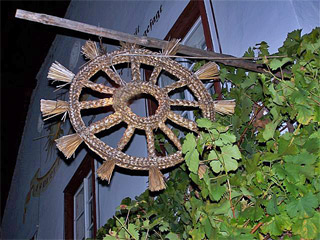
The laws for heurigers were designed to allow vintners to make some extra income without hurting the restaurants in the area. Thus they can only sell products that are grown and made on their own farm. No hot foods are allowed. They can stay open for three months only during the harvest. Weingut Brustbauer is open only on weekends. A special symbol made of straw is displayed at the entrance to indicate when a heuriger is open. We were in luck; tonight it was hanging there in all its glory to welcome us.
The family lives in a 600 year old home next door and the vineyards and farm spread out across the rear. The tavern is totally casual and informal with a good-natured warm welcome. Happy diners were enjoying platters of smoked meats, cheese, wine and baskets of dense grainy bread. We soon found out why everyone was so jovial.
Mixed salad was fresh out of the garden. Lean slices of smoked pork, veal and sausage were deliciously flavored and well-paired with the emmentaler cheese and marvelous bread (this would be the beginning of a bread eating spree). The dry delicious Riesling wine went perfectly with the food.
Tonight marked the start of an apple strudel competition that lasted three weeks. It would be impossible for one to compete with this old fashioned, homemade version. Tender dough was filled with the perfect flavor and texture of an apple, raisin and cinnamon mixture. The house offered an apricot brandy to finish.
In Austria the word for apricot is marille and it's as integral to life in the Wachau as the wine. Marille is everywhere - in the Wieser shop in Durnstein, we found it all: apricot soap, shampoo, lip balm, body lotion, marmalade, brandy, liqueur etc.
It's an invigorating experience to climb up a path in the terraced vineyards, stand among the vines smelling the delicious aromas and view the network of terraces along the hillsides right down to the winding Danube River. We reached a spot where there is platform and bench and we sat mesmerized by the beauty surrounding us.
If you are so inclined, the Danube
Bicycle Path, which runs along both sides of the river,
is a marvelous way to explore and enjoy the river valley.
[Back
to Top]
The Melk Abbey, has been an important spiritual and cultural center for over 1000 years. Originally it was a residence of the Babenberg family and since 1089 a Benedictine monastery. It's a dramatic golden ochre, white trimmed, twin towered Baroque structure resting on a precipice overlooking the Danube, surrounded by a park and gardens.
Monks dedicated to the rules established by St. Benedict, have worked in Melk Abbey for over 900 years. Today thirty monks belong to the community of the Benedictines in Melk Abbey. Their primary duties are pastoral care, being responsible for twenty-three parishes, and education in the abbey secondary school with 900 students. Other duties are in the areas of culture, tourism and economy.
The abbey museum has been designed into the former Imperial Rooms. The exhibition is entitled, "The Path from Yesterday to Today - Melk Abbey in its Past and Present". It cleverly tells the story of the monastery's ups and downs over its 900 year history. The extraordinary art treasures on display along with video and computer animation make the presentation very compelling.
A visit to the monastery also
includes the Marble Hall, Library and Abbey Church. The
Marble Hall was a guest dining hall for festive occasions.
Only the door frames and the insets over the doors are
made of real Salzburg marble. The walls are stucco marble.
The ceiling fresco painted by Paul Troger in 1731, framed
by an architectural painting by Gaetano Fanti, is quite
exquisite. 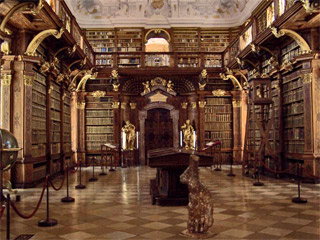
The terrace that connects the Marble Hall and Library offers a lovely view of the Danube and the western facade of the Abbey Church. The library is a masterful Baroque creation. A ceiling fresco by Troger-Fanti is a counterpoint to the work in the Marble Hall and shines down on the inlayed bookshelves with matching book binders. The impact of the thousands of identically bound books in this environment is a sight not easily forgotten.
A spiral staircase leads down to the church. The Rule of St. Benedict requires that nothing be more important than the worship service. This monument to glorious baroque design surely fulfills that demand. Warm hues of gold, ocher, gray, green and orange of the frescoed ceiling, stucco marbled walls and galleries create a feeling of comfort and serenity. The high alter of the presbytery done in gilded wood, gold and Salzburg marble is quite magnificent and dominating.
The grounds of Melk Abbey make up a substantial part of the entire baroque monastic ensemble. The baroque garden pavilion has famous frescoes by Johann Wenzel Bergl. The abbey park was originally done in baroque in 1750, redone as an English landscape park in 1822 and a revitalization project was started in 1995 adding some new elements. The day was beautiful and it was a delight to stroll about amongst the greenery.
The Abbey restaurant is located between the parking lot and the entrance and rumor has it that the food is very good. We sampled only the coffee, which was excellent, then found our way to The Hotel-Restaurant Post of the Familie Ebner, Linzer Strasse l, where we were warmly greeted by the owner and staff. The casual dining room and friendly staff made us feel right at home.
The menu offered a tantalizing array of game and local fish dishes. Linda had goulash of chanterelles (eierschwammer gulasch) with bread dumplings (semmelknodeln) and I a carp fillet with piquant cranberry sauce and vegetable noodles (karpenfilet auf sus-scharfer preiselbeer sauce mit gemusenudelin). The mushrooms and fish were very fresh and lovingly prepared. Some kind of knodeln (dumplings) or nudelin (noodles) are standard with all meals.
It should be noted that portions are very large in Austria. It is possible to share or order smaller portions in most restaurants. Dining is a major part of the Austrian lifestyle and we came home with the extra kilos to prove it. Restaurants of all types have to be good to survive so it is difficult to find a bad meal. We found prices to be very reasonable for the quality of the ingredients, service and ambiance. Go Austria!
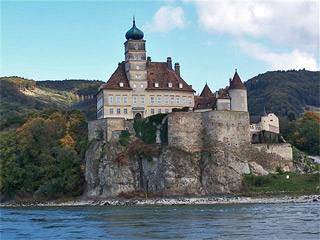 A visit to the
Wachau must include a cruise on the Danube. The Brandner Line, offers a variety of cruise options from
Austrian Brunch and Brass Music to Evening Wine and Dine.
We opted for a simple excursion from Melk to Krems which
takes just under 2 hours. It was delightful to see the
sights of the south side of the river up close and a
different perspective of the north bank.
A visit to the
Wachau must include a cruise on the Danube. The Brandner Line, offers a variety of cruise options from
Austrian Brunch and Brass Music to Evening Wine and Dine.
We opted for a simple excursion from Melk to Krems which
takes just under 2 hours. It was delightful to see the
sights of the south side of the river up close and a
different perspective of the north bank.
[Back
to Top]
A friend told us that there were two wonderful restaurants in nearby Durnstein, one in the Romantik Hotel Richard Lowenherz (Richard the Lionhearted), the other in the Hotel Schloss Durnstein (a Relais & Chateaux property). Both hotels are in the Thiery family with sister and brother operating them respectively.
Tonight we would dine at Richard the Lionhearted. The hotel has been operated by the family since 1884, now in the third generation. Located right on the banks of the Danube in the former medieval Convent of the Clares, surrounded by the convent walls, it radiates a warm, homey atmosphere. Before dining we couldn't resist sitting in front of the large open fireplace in the old refectory and sipping an apricot brandy, very romantic!
The walls of the terraced restaurant are adorned with ancient artifacts and photos of famous artists of the 19th and 20th century who met here. The menu of updated traditional dishes and autumn specials might have presented a decision dilemma but it was really easy, the autumn specials won our hearts. This was our first cream of pumpkin soup of the trip. The standard was set for the many others along the way. Pureed pumpkin with a touch of cream, pumpkin oil and a handful of pumpkin seeds was a formula for pure delight. Soup was followed by a small mixed salad with a light yogurt dressing, a basket of dense, dark nut bread, salt sticks, muesli rolls and an amuse bouche of a succulent grilled scallop on rice noodles. There was ample time between courses to savor the flavor and enjoy the wines from the ancient convent vineyards.
Our game dishes of deer stew (hirschragout) and roast saddle of young wild boar (frischlingsrucken) were a dream come true. The deer was served with Brussels sprouts and sliced dumplings with chanterelles and the boar was accompanied by red wine cabbage, cranberries and chestnut dumplings. It was interesting to learn that though they taste the same, cranberries here grow wild in the mountains and are much smaller than the ones at home which grow in bogs.
Weissenkirchen (white churches) is a life-size postcard. Surrounded by mountains and vineyards, the narrow streets and lanes are lined with charming old buildings in shades of pink, green, blue, yellow, rose, and beige.
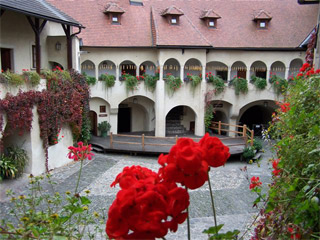 The Wachaumuseum
Weinseminar is located in what was once a fortress. The
wide inner courtyard is used for exhibitions, festivals
and entertainment. There are many wine-related activities
such as the Rieslingfest in August. The rooms off the
first floor balcony surrounding the courtyard house the
museum's exhibitions. We loved the old paintings and
photographs of the area featuring landscapes and most
intriguing the ones depicting people hard at work in the
vineyards working the vines and grapes. There's a large
attractive room with paintings adorning the walls that is
used for wine tastings and private parties. Another
ground floor room was hosting a tasting party for locals.
Most were dressed in traditional Austrian attire. A sweet
man came out and was very agreeable to posing for a photo.
This village of 1500 residents is adorable.
The Wachaumuseum
Weinseminar is located in what was once a fortress. The
wide inner courtyard is used for exhibitions, festivals
and entertainment. There are many wine-related activities
such as the Rieslingfest in August. The rooms off the
first floor balcony surrounding the courtyard house the
museum's exhibitions. We loved the old paintings and
photographs of the area featuring landscapes and most
intriguing the ones depicting people hard at work in the
vineyards working the vines and grapes. There's a large
attractive room with paintings adorning the walls that is
used for wine tastings and private parties. Another
ground floor room was hosting a tasting party for locals.
Most were dressed in traditional Austrian attire. A sweet
man came out and was very agreeable to posing for a photo.
This village of 1500 residents is adorable.
The picturesque village of Durnstein was built between granite cliffs and forests and the Danube River. Most people associate Durnstein with the story of Richard the Lion-Hearted (thus the name of the hotel). The famous English King is said to have ridiculed the Austrian flag during the Third Crusade. Returning home through Austria he was recognized, captured and imprisoned in the Durnstein Fortress where he remained until rescued by his faithful vassal, the minstrel Blondel. The story has not been proven to be historically accurate but adds to the romance of Durnstein.
An architectural delight greets one
at every turn. Intriguing archways, roofs, textures, and
colors are a feast for the eyes. 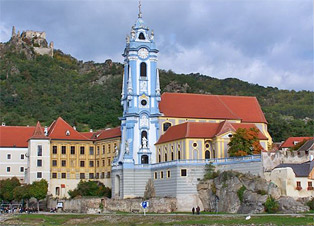 Of particular note
is the Rathaus complex and the Durnstein Abbey. The
exquisite blue and white steeple of the Abbey rises
gracefully as a landmark on the banks of the Danube. The
striking colors create a ceramic effect in contrast to
the grey and yellow abbey and church. The grey represents
earth and the blue and white symbolizes heaven.
Of particular note
is the Rathaus complex and the Durnstein Abbey. The
exquisite blue and white steeple of the Abbey rises
gracefully as a landmark on the banks of the Danube. The
striking colors create a ceramic effect in contrast to
the grey and yellow abbey and church. The grey represents
earth and the blue and white symbolizes heaven.
We strolled the streets to find
many shops selling their homemade goodies (hausgemachte
spezialitaton) like jams, jellies, marmalade, syrups,
cheeses, meats and of course wine. The Backerei Schmidl
produces a simple crusty fairly dense roll that is famous
around the world.
[Back
to Top]
Today we would lunch at the Hotel Schloss Durnstein, a castle built in 1630, which the Thiery family has transformed into a five-star hotel. We took a tour of the facilities before lunch. Each room and suite is different, but all have carefully selected antique furnishings, fixtures and fittings, yet modern technology, and there is a wellness center with connecting indoor and outdoor pools.
The restaurant consists of three intimate rooms on three levels. The vaulted ceilings and walls are painted soft peach with matching furnishings and linens creating a relaxing dining atmosphere. It was too bad it was not warm enough to dine on the terrace which affords a stunning view of the winding Danube. Once again, we opted for seasonal wild specialties. Linda's cream of pumpkin soup was accompanied by potato-pumpkin strudels. I opted for the cream of chestnut with crispy wild boar-rosemary strudel. Both were outstanding.
Linda was served sliced filet of venison reposing on pumpkin-filled agnolotti with juniper sauce studded with grilled zucchini and forest mushrooms. I had filet of deer with red wine cabbage and potato noodles. The meats were flavorful, tender and juicy. Wonderful food, ambiance and service - brother and sister succeeded in making our dining in Durnstein a memorable experience.
A visit to Freie Weingartner Wachau in Durnstein, further enhanced our Wachau wine wisdom. This cooperative of 700 members cultivates 250 hectares of vineyards. The modern retail showroom does a great job of presenting the wine and educating the visitor. The cellar facilities are very impressive and the tour ends in Kellerschloessl, a unique baroque building from 1715, located on the edge of the single vineyard Kellerberg which has been the trademark of the organization since its beginning.
The narrow segment of the Danube valley between Melk and Krems was designated as Vinea Wachau Noblis Districtus. The vintners gave new life to this ancient designation in 1983 when they founded Vinea Wachau which created three categories for the classification of Wachau wines: Steinfeder, a light specialty, Federspiel, the classic wine, and Smaragd, the great wine of Wachau. These wines are produced with strict guidelines and controls. Members of Vinea Wachau must sell wines exclusively from the Wachau area.
The time difference was beginning to catch up with us so a late afternoon nap was in order. We did manage to wake up for dinner in Krems at Ulli Amon-Jell, Hoher Markt 8-9. This old house is loaded with Wachau tradition from the old furniture and artifacts to the wine bottles on display and the menu. It is a real homey place, with pleasant staff and casual service.
The menu is in German only and the staff does not speak English, but that is no obstacle for seasoned menu readers. We quickly identified potato soup which turned out to be a hearty rendition chock full of potato pieces, mushrooms, onion and parsley. Good soup demands good bread and the multigrain rolls on the table did the trick.
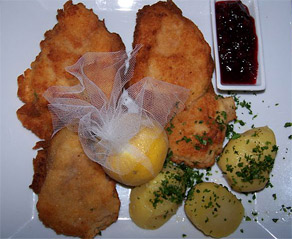 Tonight Linda indulged her love of schnitzel,
which turned out to be the best of the trip. A juicy
slice of tender pork with luscious, crisp batter and
roast potato kept her busy for a while. She ate and ate
and there was still enough left to make two sandwiches
for us to eat on the train the next day. I feasted on a
rib steak covered with sautéed and crisply fried onions
and roast potato. Both mains came with large mixed salads.
Taking a break from the great wine, we ordered rich,
creamy dark beer. We shared chocolate mousse mit schlag (whipped
cream, the real honest-to-goodness stuff), and an
assortment of fresh fruit.
Tonight Linda indulged her love of schnitzel,
which turned out to be the best of the trip. A juicy
slice of tender pork with luscious, crisp batter and
roast potato kept her busy for a while. She ate and ate
and there was still enough left to make two sandwiches
for us to eat on the train the next day. I feasted on a
rib steak covered with sautéed and crisply fried onions
and roast potato. Both mains came with large mixed salads.
Taking a break from the great wine, we ordered rich,
creamy dark beer. We shared chocolate mousse mit schlag (whipped
cream, the real honest-to-goodness stuff), and an
assortment of fresh fruit.
This is the typical traditional style of family-operated restaurant that is prevalent throughout the country, where good home cooking is offered at reasonable prices.
Tomorrow morning we will leave the
Wachau region with fond memories of our first days in
Austria in 2005.
[Back
to Top]
Wachau_Krems_Melk_Durnstein
Salzburg | Kufstein_Kitzbuehel
Rattenberg_Hall | Innsbruck
Zell Am See_Kaprun | Spittal
Klagenfurt | Graz | Vienna
Search TheTravelzine | TheTravelzine Group | Don's Gallery
Packing Hints | Planning
Tips | Cities
Links
All pages on TheTravelzine.com©Copyright 1996-2020 Don & Linda Freedman